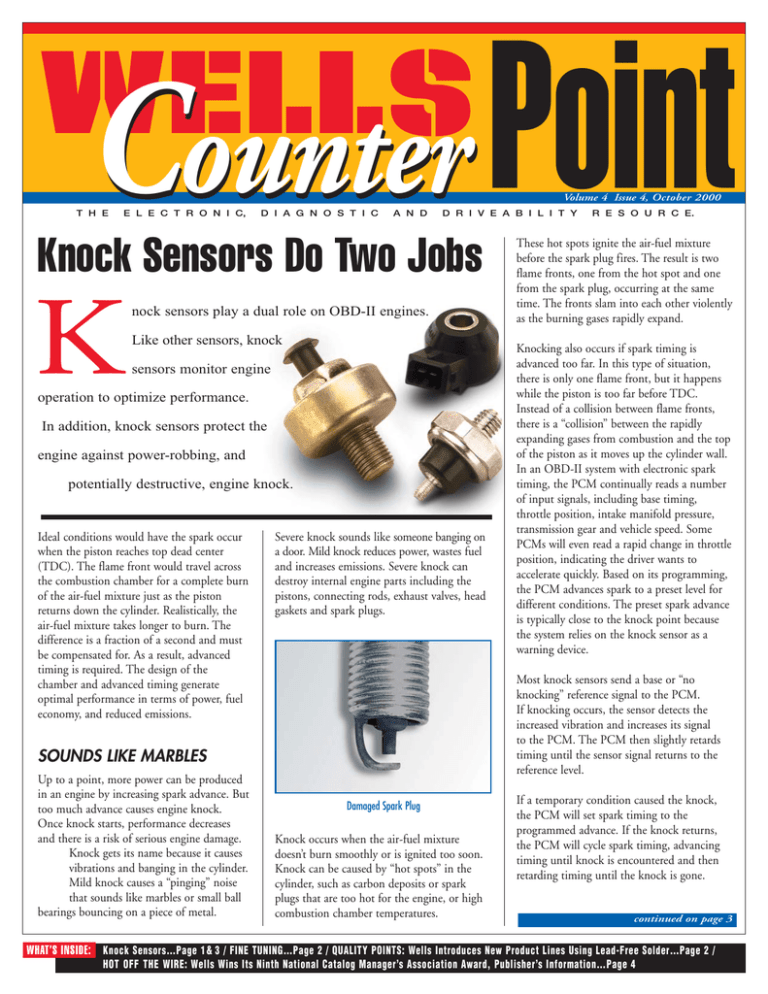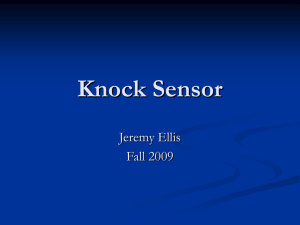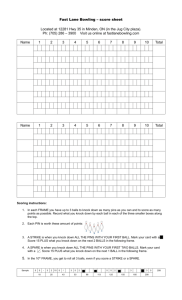
Counter Point
Volume 4 Issue 4, October 2000
T H E
E L E C T R O N I C,
D I A G N O S T I C
A N D
D R I V E A B I L I T Y
Knock Sensors Do Two Jobs
K
nock sensors play a dual role on OBD-II engines.
Like other sensors, knock
sensors monitor engine
operation to optimize performance.
In addition, knock sensors protect the
engine against power-robbing, and
potentially destructive, engine knock.
Ideal conditions would have the spark occur
when the piston reaches top dead center
(TDC). The flame front would travel across
the combustion chamber for a complete burn
of the air-fuel mixture just as the piston
returns down the cylinder. Realistically, the
air-fuel mixture takes longer to burn. The
difference is a fraction of a second and must
be compensated for. As a result, advanced
timing is required. The design of the
chamber and advanced timing generate
optimal performance in terms of power, fuel
economy, and reduced emissions.
Severe knock sounds like someone banging on
a door. Mild knock reduces power, wastes fuel
and increases emissions. Severe knock can
destroy internal engine parts including the
pistons, connecting rods, exhaust valves, head
gaskets and spark plugs.
These hot spots ignite the air-fuel mixture
before the spark plug fires. The result is two
flame fronts, one from the hot spot and one
from the spark plug, occurring at the same
time. The fronts slam into each other violently
as the burning gases rapidly expand.
Knocking also occurs if spark timing is
advanced too far. In this type of situation,
there is only one flame front, but it happens
while the piston is too far before TDC.
Instead of a collision between flame fronts,
there is a “collision” between the rapidly
expanding gases from combustion and the top
of the piston as it moves up the cylinder wall.
In an OBD-II system with electronic spark
timing, the PCM continually reads a number
of input signals, including base timing,
throttle position, intake manifold pressure,
transmission gear and vehicle speed. Some
PCMs will even read a rapid change in throttle
position, indicating the driver wants to
accelerate quickly. Based on its programming,
the PCM advances spark to a preset level for
different conditions. The preset spark advance
is typically close to the knock point because
the system relies on the knock sensor as a
warning device.
Most knock sensors send a base or “no
knocking” reference signal to the PCM.
If knocking occurs, the sensor detects the
increased vibration and increases its signal
to the PCM. The PCM then slightly retards
timing until the sensor signal returns to the
reference level.
SOUNDS LIKE MARBLES
Up to a point, more power can be produced
in an engine by increasing spark advance. But
too much advance causes engine knock.
Once knock starts, performance decreases
and there is a risk of serious engine damage.
Knock gets its name because it causes
vibrations and banging in the cylinder.
Mild knock causes a “pinging” noise
that sounds like marbles or small ball
bearings bouncing on a piece of metal.
R E S O U R C E.
Damaged Spark Plug
Knock occurs when the air-fuel mixture
doesn’t burn smoothly or is ignited too soon.
Knock can be caused by “hot spots” in the
cylinder, such as carbon deposits or spark
plugs that are too hot for the engine, or high
combustion chamber temperatures.
If a temporary condition caused the knock,
the PCM will set spark timing to the
programmed advance. If the knock returns,
the PCM will cycle spark timing, advancing
timing until knock is encountered and then
retarding timing until the knock is gone.
continued on page 3
WHAT’S INSIDE: Knock Sensors…Page 1 & 3 / FINE TUNING…Page 2 / QUALITY POINTS: Wells Introduces New Product Lines Using Lead-Free Solder…Page 2 /
HOT OFF THE WIRE: Wells Wins Its Ninth National Catalog Manager’s Association Award, Publisher’s Information…Page 4
Fine Tuning questions are answered by
Mark Hicks, Technical Services Instructor.
Please send your questions to: Mark Hicks
c⁄ o Wells Manufacturing Corp.,
P.O. Box 70, Fond du Lac, WI
54936-0070 or e-mail him at
technical@wellsmfgcorp.com.
We’ll send you a Wells’ shirt if your
question is published. So please include
your shirt size with your question.
Fine Tuning
Q: On a 1997 Taurus 3.0 L, DIS, automatic,
with 40,000 miles, the engine starts and
runs OK, but it will set codes P0303
(misfire #3) and P0304 (misfire #4) after a
few minutes of driving. The scope shows no
problem with secondary ignition. Cylinders
3 and 4 share a coil, which was replaced,
but the problem continues. What now?
South Hampton Shell, South Hampton, NJ
Recheck the scope readings and spark plug
wire routing. When replacing a coil pack, you
may also want to check the spark plug wires.
High secondary resistance can cause high RFI
levels, which can affect the vehicles wiring
and trigger false misfire codes.
Q: We have a 1997 Chevrolet Malibu that
seems to have a carbon-tracking problem
in the ignition coil housing. We replaced
the housing and spark plugs some time
back, but not the coils. The car is in for a
hard starting/poor performance complaint
and needs new coils. When we removed
them, we noticed that the carbon tracking
was back. The plugs look OK and so does
the rest of the housing. The weird thing is,
you can wipe off some of the carbon
tracking with a rag. What causes this?
Will’s Autoworks, Trenton, NJ
Many ignition coil housings from the Quad
4 and Twin Cam engines can develop a
characteristic marking that is often mistaken
for carbon tracking. These marks are a
characteristic of the high voltage distribution
through the coil housing that can develop
over a period of time. Vehicle operation and
climate are also a factor. These false “carbon
tracks,” which can be wiped off with a damp
cloth, can be often seen on the bottom of the
housing between the secondary ignition
terminals. Real carbon tracking from a high
voltage arc is characterized by damage to the
coil housing with black residue or carbon
imbedded in the housing material. This type
of damage can not be wiped away very well,
and can often be felt as well as seen.
Q: We have a 1996 Ford Aerostar, 4.0 L
engine and automatic, that keeps setting a
DTC P1443 (Evaporative Emission). The first
time, we ran the diagnostic procedure, we
replaced the evaporative canister purge
solenoid, and cleared the code. But P1443
returns after the van has been driven
for about an hour or so. Repeating the
diagnostic procedure doesn’t turn up any
other problem. What do you think?
Phil’s Mobil Service, Denver, CO
Be sure to check the fuel tank filler cap seal
carefully. The P1443 DTC can also be set by
problems with the purge flow sensor. If the
code keeps coming back, but the diagnostic
routine doesn’t uncover a problem, be
sure to check the purge flow sensor as well.
Quality Points
Wells Introduces New Product Lines Using Lead-Free Solder
To keep with international standards and
prevent the environmental and health concerns
related to lead bearing solders, Wells has taken
the leadership role and implemented lead-free
solder on its new DIS (distributorless ignition
systems) family of products along with its
OEM line of GM regulators.
To implement lead-free solder on these
products, Wells had to revise its soldering
process. Instead of the past practice of using
IR (infrared) or convection heating where
the component was close to or hotter than
the solder being melted, Wells went to a
conduction method of heating. With the
conduction method of heating the
component, temperature could be 30 degrees
cooler than the solder temperature. This
soldering method allowed the re-flow
temperature to be high enough to process the
lead-free solder and still not damage the
components. Wells also had to develop a
2
Diagnose The Problem Win A Shirt
A 1997 Ford Taurus 3.0 L keeps setting
misfire codes. The codes vary among
cylinders #1, #4, #5, and #6, but no miss
is felt, even when driving the car very
hard. The PCM has been reprogrammed
according to a Ford TSB on false misfire
codes. All of the spark plugs, spark plug
wires, and the fuel filter have been replaced.
The ignition coil pack output, spark plug
wire resistance, fuel injector supply voltage,
resistance, voltage drop under load, fuel
pressure and pressure drop at the injectors
are all within specification. The crankshaftposition sensor appears to operate normally.
No mechanical problems were found on the
engine. What could be causing the random
misfire codes?
The first reader to respond with the most accurate
answer via e-mail or fax, and the first reader to
respond with the most accurate answer via
snail-mail, each will receive a Wells golf shirt.
The answer, and the winners’ names, will
appear in the next issue.
Here is the answer to last issue’s question
regarding the backfiring 1995 Mercury 4.6L:
Rapid spark plug fouling indicates an
extremely rich condition. Rich fuel
mixtures usually backfire through the
exhaust, not the intake manifold, unless
the exhaust is blocked. In these cases,
check for a restriction in the exhaust or
catalytic converter, as was the problem here.
The first correct answer we received by
e-mail/fax was from Mike Smith (AC Delco,
ATSG certified instructor) of Smitty’s Garage
in Cogan Station, PA.
The first correct answer we received by
“snail mail” was from William Sherman
(ASE Master Auto, Truck, Machinist, L1,
and Advanced Truck electrical diesel engine
diagnosis) of The Original Auto-Doctor
of Oak-Hill, FL. Congratulations!
solder paste, which would handle the demands
of the automotive environment. Wells worked
with its solder paste vendors to create a solder
alloy that would handle the severe thermal
shocks seen in underhood automotive
applications. The material had to be process
friendly and maintain the high quality levels
for which Wells is known. In conjunction
with the great support from our
suppliers, Wells was able to obtain a
paste that would meet our requirements.
Today Wells is processing millions of
parts with this environmentally-friendly solder
while continuing to maintain its world-class
quality levels.
continued from page 1
TRIGGER SOURCE
Knock Sensors Do Two Jobs
Tap Tap Tap Tap Tap
DIAGNOSTICS
Check the functioning of the knock
sensor and look for things that cause
knocking like engine condition, timing,
temperature, etc. Although the noise that
knocking makes is hard to miss, some
customers may not tell you they hear a
knocking sound. Instead, the complaint will
be typical of poor engine performance – loss
of power, poor acceleration, drop in fuel
economy, etc.
To prevent knock damage, some
manufacturers program the PCM to retard
timing if no knock sensor signal is detected.
On these engines, if the knock sensor fails,
instead of constant knocking, the engine will
perform poorly because timing will be
retarded all the time.
The knock sensor is normally placed in the
engine block, but occasionally you’ll find a
sensor mounted in the cylinder head.
One sensor is used on inline engines. On a
“V” engine, there are usually two
sensors, one in each bank of the “V.”
In an OBD-II system, a failed knock
sensor should set a DTC of P0324 to
P0329. If the engine has two knock
sensors; the second sensor will set DTC of
P0330 to P0334.
A scope can be used to check the operation of
the knock sensor. You can also use your scan
tool to check for codes as well as watching
the timing changes as you check the operation
of the knock sensor. Monitor the knock
sensor signal and spark timing while simulating
a knocking condition by tapping on the
engine block or cylinder head with a soft face
mallet. To the sensor, the vibration caused by
striking the engine is the same as knock.
You should see a signal going from the sensor
to the PCM. The PCM, in response to the
signal, should retard timing as long as you
keep striking the engine block.
When you stop hitting the engine block, the
sensor signal should return to the base level
and the PCM should advance timing.
• Channel 1
• OC Coupling
• Auto Baseline
• Normal Acquisition
• Post Trigger
Scope Leads
-+
50 Millivolts - Per Division
.5 Seconds - Per Division
A new sensor may be dry, or it may have
coated threads. Install the sensor as it
comes from the box. Never add any locking
compound or other coating to a dry sensor.
Knock sensors operate in a tough
environment. They must tolerate the dirt and
grease that is normally found under the hood,
plus all the moisture, dirt, road salt, etc. that
may accumulate. Be sure to check all
connections and wiring for corrosion and
damage before condemning the sensor.
Tap with tool
KNOCKING
If you can simulate a knock signal, you should
see timing retarded on the scan tool or timing
light. This would indicate that the PCM is
functioning properly and the problem is with
the sensor or the wiring. If the timing doesn’t
retard with a simulated signal, the PCM or its
wiring may be faulty.
The knock sensor can also be checked using a
tester that connects across the sensor
terminals. With the engine warmed up and
running, rap on the block near the sensor. The
tester should flash as you hit the block,
indicating that the sensor is sending a signal to
the PCM.
REPLACEMENT TIPS
Knock sensors are dependable, so you may
not get a lot of experience changing them.
These tips will help you do the job properly:
1.) Many sensors look alike, physically. But
the sensor is matched to the engine and
the PCM. Since all engines vibrate, the
engineers must spec the knock sensor so
that it doesn’t react to “normal” vibration
and only reacts to knocking. The wrong
sensor, even though it fits, may not work
properly because it won’t correctly identify
normal and knocking vibration.
2.) Make sure you use the right part number.
Knock sensors are either threaded into the
block, or inserted and held with a clamp.
With threaded sensors, use the vehicle
manufacturer’s specified torque to tighten
the sensor. If you can’t find a torque setting,
snug the sensor down securely. If the sensor
isn’t secure in the block, it won’t be able to
properly detect vibration.
3
If there is a knock complaint, and the knock
sensor and PCM are operating properly, this
could mean that there is a serious problem
with the engine. There are many possible
sources for knocking.
Some engines are prone to knocking. The
engines that are likely to knock are usually
high performance and poorly maintained.
Both situations require the engine to
continually operate at the edge of knocking.
Using gas with a low octane rating can cause
knocking too. Always use the octane rating
recommended by the vehicle manufacturer.
With gas prices increasing, ask the owner if
he or she has switched to a lower octane fuel
than the vehicle requires in order to save money.
Anything that increases combustion chamber
temperature can cause knocking such as failure
of the EGR, a cooling system problem,
burning engine oil, or incorrect spark plug
heat range.
A too lean condition, such as a PCM, fuel
system or a vacuum leak problem, can also
cause knocking.
On an older vehicle, especially one used
primarily for stop-and-go driving, deposits
can build up in the combustion chamber
leading to the hot spots that cause knocking.
Identifying the source of knocking can take
some detective work, but the problem has to
be corrected. Constant knock not only hurts
performance and increases emissions, it can
severely damage the engine.
◆
WELLS MANUFACTURING CORP.
P.O. Box 70
Fond du Lac, WI 54936-0070
INSIDE:sors
en
Knock S
Hot off the Wire
Wells Wins Its Ninth National Catalog Manager’s
customers can now maximize their return on
Association Award
investment.... By incorporating Well’s Alpha
Wells Manufacturing
Corporation has recently
been awarded its ninth
President’s Award for
Catalog Excellence by
the National Catalog
Manager’s Association (NCMA).
Each year the association
bestows an award to a member
company based on their
catalog’s layout, ease of use
and cover design.
“We’re proud to have our
work recognized by our
peers.” said Tom Hobson, Wells
Marketing Manager. “Our catalogs are much
more than lists of parts and car models, our
Locator Plan-O-Gram System into our catalogs,
our retailers, distributors and installers can use
their space and time more efficiently.”
Wells offers catalogs covering its 19,000 part
numbers. They are Engine Management
Volumes 1 & 2, Illustrated Parts Guide, Wire
and Cable, Fuel Systems, Farm, Industrial,
Medium/Heavy Duty Truck, Fuel
Injection and Marine. Products
covered are engine management,
including ignition, emissions, wire
and cable, battery accessories and fuel
management components for domestic
and import cars, trucks, vans, agriculture
and marine applications.
Parts stores and shop owners can get copies
of Wells’ catalogs by calling their Wells supplier.
Publisher’s Information
Wells’ President ..............William Allen
Vice President Sales ........Gavin Spence
Technical Services Instructor... Mark Hicks
Newsletter Editor...........Brendan Lopez
Counter Point is a quarterly publication of Wells
Manufacturing Corp., P.O. Box 70, Fond du Lac, WI
54936-0070. Letters and comments should be
directed to: Counter Point Editor,
c/o Wells Manufacturing Corp, P.O. Box 70,
Fond du Lac, WI 54936-0070.
© COPYRIGHT 2000 WELLS MANUFACTURING CORP.
All rights reserved. No reproduction in whole or part is permitted
without the written consent of Wells Manufacturing Corp.




